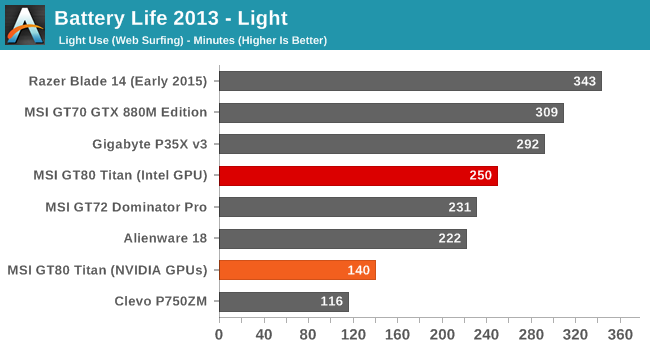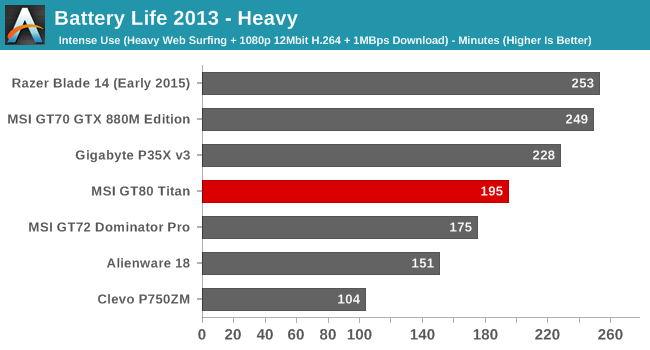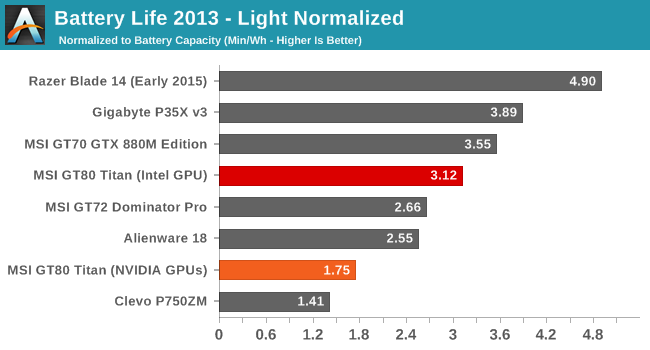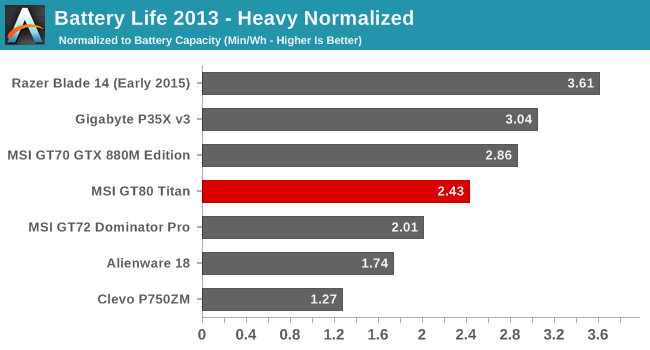The MSI GT80 Titan Review: The Broadwell Gaming Laptop Your Desktop Envies
by Brett Howse on June 26, 2015 8:00 AM ESTBattery Life
Normally on a notebook review, I would consider battery life to be one of the key aspects of the experience. However the GT80 Titan is not a typical notebook. This is really a device designed to sit on a desk and be used in lieu of a desktop computer. But if you ever feel the need to pick up this 10 pound laptop and lug it to the coffee shop, I suppose we should see what kind of battery life you can expect.
The GT80 Titan lacks NVIDIA’s Optimus technology, so it can’t switch from the discrete graphics to integrated graphics on the fly. MSI has included a hardware switch to change to integrated graphics, but it does require a reboot in between. Just to see how much of a difference this makes, I ran the light test first with the GTX 980Ms active, and then again leveraging Intel’s integrated GPU.

Our light test is light web browsing with the display set at 200 nits. The 80 Wh battery inside the GT80 Titan is really no match for the hunger of the SLI graphics cards, and with those enabled the battery life is a mere two hours and twenty minutes. However once you disable the GPUs and switch to the integrated GPU, the result is actually a pretty respectable four hours and nine minutes. Considering the size of the display and the power underneath the covers, I was actually shocked it was that high.

The heavy test ramps up the amount of pages browsed, adds in a 1 MB/s file download, and a movie is played back using the Windows 8 Video app. On most devices, the light test result is often dictated by the display power, and the heavy test shifts that balance over to the CPU and I/O. However with the power hungry components in the GT80, the difference between the light and heavy tests results is less than normal with it getting just about an hour less overall. Even though it is just three hours fifteen minutes, it actually ties the Sony Vaio Haswell based Ultrabook in this test, but it does have over double the battery capacity of that much smaller notebook.


Looking at the normalized graphs, the GT80 shows just how much energy is needed to power the CPU and large display. Once you turn on the GPUs though, the power usage really gets ugly and the light result with the GPUs enabled is one of the worst we have seen. Even though NVIDIA has been improving power efficiency and idle draw of their GPUs, they still are not in the same league as the 14nm Intel GPU when discussing minimum power draw.
Charge Time
In order to provide enough power for the two GPUs plus the quad-core CPU, MSI ships the GT80 Titan with a massive 330 watt A/C adapter. This power brick alone weighs more than some notebooks, but it is necessary to keep up with the insane power requirements of this notebook. With that much power available, MSI could have chosen to reduce the charge time pretty substantially.

Looking at the time though, the GT80 charges in roughly the same time as most notebooks. Even though they could have provided more power to the battery, this may have required beefed up circuitry, and even if that is there, it can be hard on the battery due to the heat generated. MSI was fairly conservative here but the end result is a fine 2.5 hours.










103 Comments
View All Comments
Notmyusualid - Saturday, June 27, 2015 - link
Well, may I ask, what are you expecting?I believe my M18x is 5.4kg.
I carry it all over the world. And I do mean that.
vladx - Friday, June 26, 2015 - link
So why not offer a 4K display option? I'm sure a dual 980M can run games on high-very high even in 4K.BMNify - Friday, June 26, 2015 - link
Because there is no one selling 4k panels for 17/18 inch laptops, so all large gaming laptops have to stick with 1080p for now.Notmyusualid - Saturday, June 27, 2015 - link
Argeed.And I'm not changing my M18x R2, until another panel at 18.4", with a resoultion of at least 1440p comes along. Preferably at 120Hz too.
The first manufacturer to tout such a screen (and with QUALITY too), is going to have a feeding frenzy on their hands from the enthusiast community.
meacupla - Friday, June 26, 2015 - link
I would not want a 4K display, unless it had a controller that could do some great 200% and 50% scaling. I've never seen any monitor/panel do a proper scaling to make it look like a lower res screen.Instead, every monitor/panel that I've seen tends to smudge, smear and distort the image being displayed, even though it's supposed to be a simple 1280x720 image being outputted to a 2560x1440 display. There should be no issues with artifacting and the sorts with that kind of direct scaling, and yet, every monitor that I have seen fails this.
As a comparison, if you tell your computer -an image program- to blow up an image to 200%, it'll do it with no distortions at all. Heck, you can even do 150% (3:2) and it'll still look better than what a monitor will do.
ViperV990 - Friday, June 26, 2015 - link
A laptop like this could really benefit for an "ezel" type hinge. Ever better if it could telescope.TallestJon96 - Friday, June 26, 2015 - link
It seems to me that this thing cools really well. I'm not much of a laptop gamer, but the change to 16/14nm processes should be a huge improvement for laptop performance.sulu1977 - Friday, June 26, 2015 - link
How can you play a game at "well over 60 fps" when laptop screens are limited to 60 fps? And if this screen can do more than 60 fps where does it say that and what's the limit?Meaker10 - Friday, June 26, 2015 - link
You can overclock the panel.Meaker10 - Friday, June 26, 2015 - link
Also some of the G-Sync displays that launched are 75hz as standard. Plus you can hook it up to external displays.